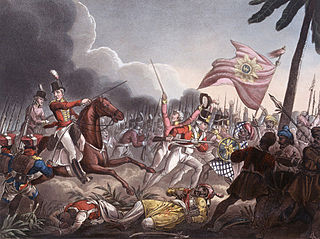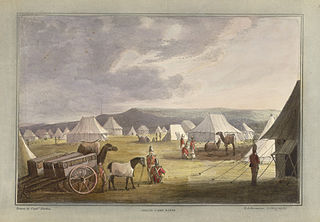 W
WThe Battle of Tiruvannamalai is one of the two successful battles fought by the Madras Army in the Carnatic along with the Battle of Chengam. It was fought on 25 September 1767 between the allied forces led by the East India Company and troops of Hyder Ali. The allied forces of the English army were led by Colonel Smith.
 W
WThe First Anglo-Maratha War (1775–1782) was the first of three Anglo-Maratha Wars fought between the British East India Company and Maratha Empire in India. The war began with the Treaty of Surat and ended with the Treaty of Salbai.
 W
WThe Anglo-Mughal war, popularly known as Child's war, was the first Anglo-Indian war and the earliest British attempt of colonization in the Indian Subcontinent that lasted from 1686 to 1690.
 W
WThe First Anglo–Mysore War (1766–1769) was a conflict in India between the Sultanate of Mysore and the East India Company. The war was instigated in part by the machinations of Asaf Jah II, the Nizam of Hyderabad, who sought to divert the company's resources from attempts to gain control of the Northern Circars.
 W
WThe Second Anglo–Mysore War was a conflict between the Kingdom of Mysore and the British East India Company from 1780 to 1784. At the time, Mysore was a key French ally in India, and the conflict between Britain against the French and Dutch in the American Revolutionary War sparked Anglo–Mysorean hostilities in India. The great majority of soldiers on the company side were raised, trained, paid and commanded by the company, not the British government. However, the company's operations were bolstered by Crown troops sent from Britain, and by troops sent from Hanover, which was also ruled by Britain's King George III.
 W
WThe Third Anglo–Mysore War (1790–1792) was a conflict in South India between the Kingdom of Mysore and the East India Company, Travancore Empire, Maratha Empire and the Nizam of Hyderabad. It was the third of four Anglo–Mysore Wars.
 W
WThe Coorg War was fought between the British East India Company and the State of Coorg in 1834. Defiance of the Raja of Coorg, a small state in South India, led to a short but bloody campaign in 1834. In February 1834, a force of 7000 was assembled under the command of Brigadier General Lindsay to commence operations against the Raja, who had begun hostilities against the British. Due to the poor state of roads, the force was divided into four columns, which were to enter Coorg from different directions and converge on the capital of Mercara. On 11 March, the Northern Division under the command of Colonel Gilbert Waugh entered the territory of Coorg and on 3 April, the leading troops made contact with the enemy. At noon, the advanced guard arrived in front of the fortified position of Soamwar Pettah. The force launched an attack on the position but was forced to retreat after a severe mauling. The leader of the Coorg resistance at was 'Madanta' (Mathanda) Appachu. Similar fate was suffered by another column.
 W
WThe First Opium War, also known as the Opium War or the Anglo-Chinese War, was a series of military engagements fought between Britain and the Qing dynasty of China. The immediate issue was Chinese official seizure of opium stocks at Canton to stop the banned opium trade, and threatening the death penalty for future offenders. The British government insisted on the principles of free trade, equal diplomatic recognition among nations, and backed the merchants' demands. The British navy defeated the Chinese using technologically superior ships and weapons, and the British then imposed a treaty that granted territory to Britain and opened trade with China.
 W
WThe Anglo-Nepalese War, also known as the Gurkha War, was fought between the Kingdom of Gorkha and the East India Company. Both sides had ambitious expansion plans for the mountainous north of the Indian subcontinent. The war ended with the signing of the Treaty of Sugauli in 1816, which ceded some Nepalese controlled territory to the EIC.
 W
WThe Second Anglo-Maratha War (1802–1805) was the second conflict between the British East India Company and the Maratha Empire in India.
 W
WThe Third Anglo-Maratha War (1817–1818) was the final and decisive conflict between the British East India Company (EIC) and the Maratha Empire in India. The war left the Company in control of most of India. It began with an invasion of the Maratha territory by British East India Company troops, and although the British were outnumbered, the Maratha army was decimated. The troops were led by the Governor General Hastings supported by a force under General Thomas Hislop. Operations began against the Pindaris, a band of Muslim mercenaries and Marathas from central India.